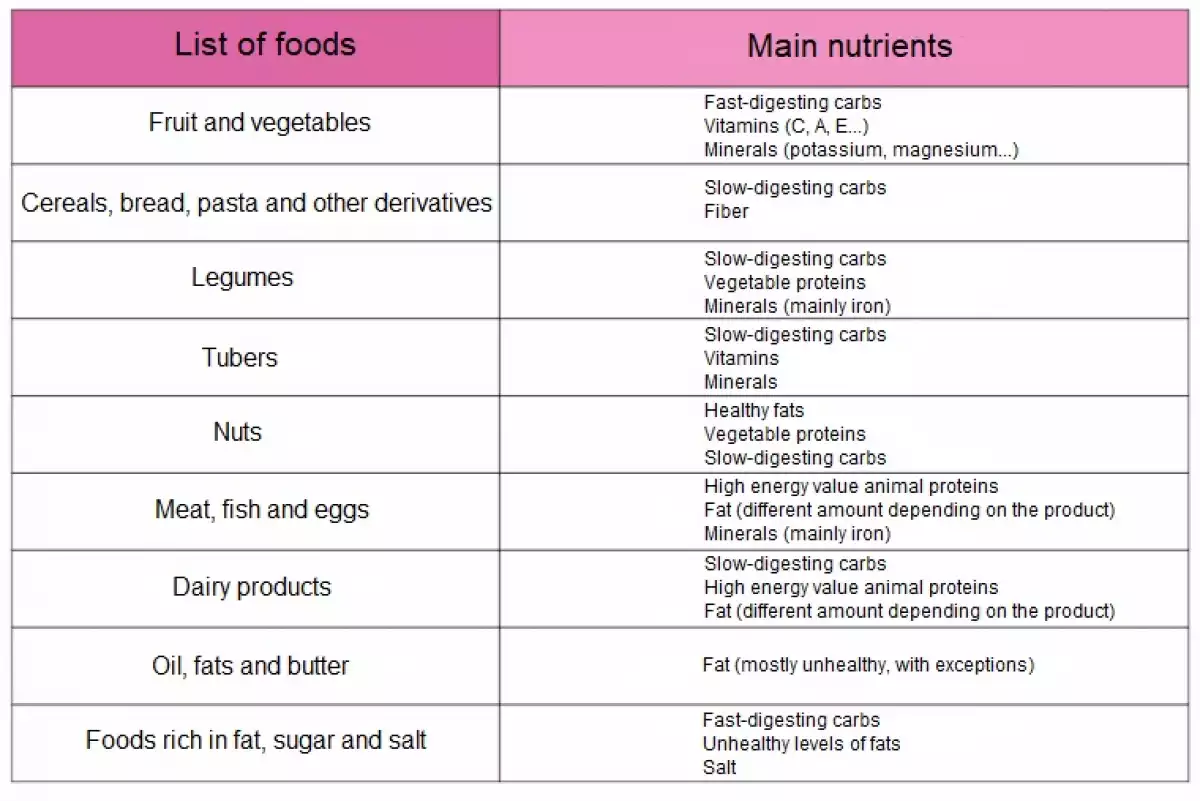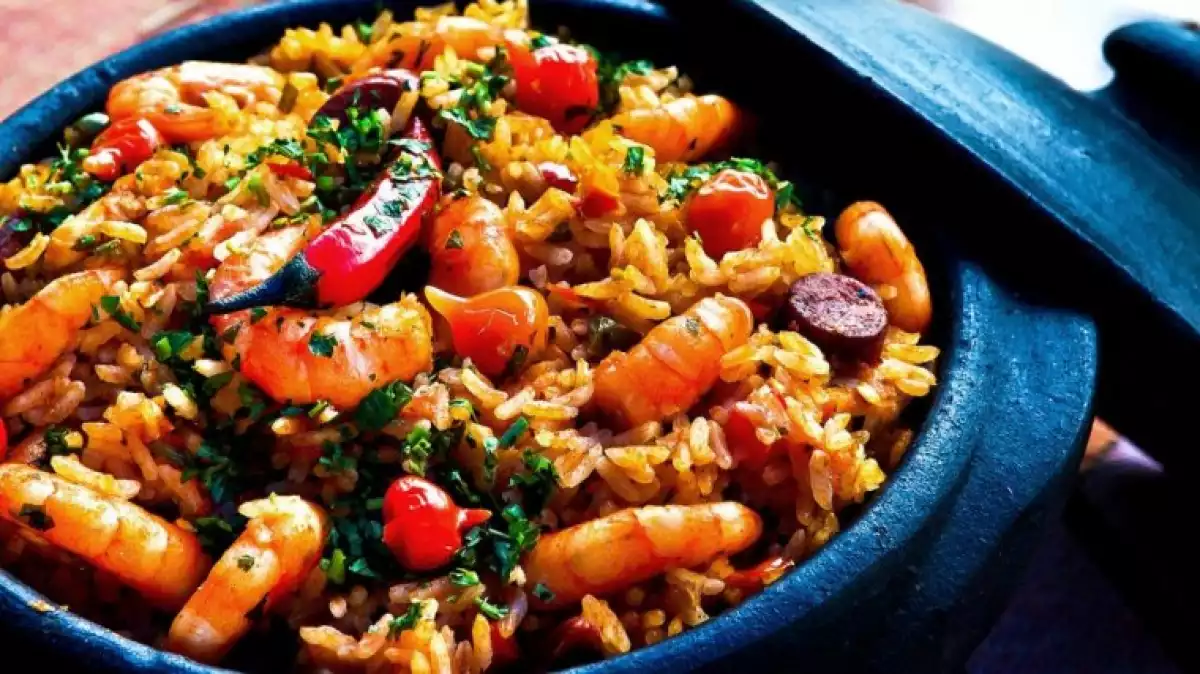
Food is the primary source of nutrients for the animals' bodies. We obtain proteins, which give a structure to our molecules; vitamins, that allow the catalyzing of physiological processes; and carbohydrates, which we need for energy.
In this article, we are going to analyze the main types of food and the nutrients each of them provides us with. We are going to divide them into 10 groups: fruits and vegetables; cereals; legumes; tubers; nuts; meat, fish and eggs; dairy products; oil and fat derivatives, foods rich in sugar or salt; and finally nutritious drinks.
Types of food and their main nutrients
In the following lines, we are going to list the 10 main food categories. Although this division is not the only one possible, we have decided to look at the most important nutrients of each of these products and their effect on the organism's health.
Apart from this kind of classification, we could also distinguish between macronutrients and micronutrients. The macro ones are the major nutrients in food. Inside this group, we can find carbohydrates, proteins, and lipids.
On the other hand, we have minority nutrients in food, which are the micronutrients. These are also known as trace elements. Vitamins and minerals belong to this group. And last but not least, we find water, which is not considered a nutrient, but that in the composition of the foods it has a significant value.

1. Fruit and vegetables
These vegetable-origin foods are the primary source of vitamins and minerals in many people's diets. In addition, vegetables and fruit have a very high nutritional value, i.e., they contain many vitamins and minerals and are low in calories. Also, they are also rich in healthy fibers that promote digestion and prevent weight gain by causing a feeling of satiety.
In a healthy diet, experts recommend 5 pieces a day: 3 of fruit and 2 of vegetables. From the last option, the best thing to do is one raw and one cooked, this will give you more vitamins and minerals.
It is preferable to include a wide variety of fruit and vegetables in the nutritional routine as this increases the range of nutrients obtained; for example, citrus fruits contain large amounts of vitamin C, while leafy green vegetables are noted for their vitamin A richness.
2. Cereals, bread, pasta and other derivatives
Within this category, all the derivatives from cereals are included such as wheat, corn, oats, rice, quinoa, barley, rye, millet or sorghum; so here we include the bread and other pastry products, pasta, oatmeal, cereal flakes or cuscús, among others.
Foods of this type provide many carbohydrates, which are used by the body as a source of energy. Cereals that preserve germ and bran are generally more nutritious than refined ones.
3. Legumes
Among the legumes, we find lentils, chickpeas, soya beans, green beans, peas, broad beans, and peanuts. This food contains similar nutrients than cereals and tubers, although its proportion of proteins and iron is higher. They are perfect to complement diets based on cereals.
4. Tubers
Tubers are thick underground stems that contain most of a plant's nutrients. The most popular are the potato and the sweet potato. This type of food is rich in starch, vitamins, and minerals, although its protein intake is relatively low.
5. Nuts
Walnuts, almonds, hazelnuts, raisins, pine nuts, pistachios, dates, chestnuts, cashews or sunflower seeds contain proteins. However, they have more fats than proteins, and although they are healthy fats, their consumption must be moderate.
The reason is that, although they provide healthy and necessary fats for our body, the total proportion of fat must not exceed that of carbohydrates, hence we must regulate their consumption.
6. Meat, fish and eggs
These type of foods have high amounts of proteins and iron, as well as a variable quantity of fats. Within this group, we have to highlight blue fish like salmon and tuna, which are rich in omega-3 fatty acids, healthier than other meat products.
It's necessary to specify that these omega-3 concentrations are considerably lower in farmed fish than in wild fish. In addition, the former may contain more toxic agents (such as heavy metals).
This means that, in the case of not being able to eat wild fish, the best option is to have small fish, which also have omega-3, but they are less toxic.
7. Dairy products
Milk, cheese, yogurt, and other dairy products are known by their high content of calcium, which is fundamental to bone growth. They also have significant levels of animal proteins, phosphorus, fatty acids, and carbohydrates, among which lactose stands out.
8. Oil, fats and butter
Butter and vegetable oils, among others, are foods with a reduced nutritional value and with high-calorie concentrations, which are different depending on the type of oil or fat.
For instance, the calories in olive oil (which is the type of fat that should be used more often because it's the most healthy one) are different from the calories in palm oil or coconut oil.
The last two we have just mentioned should be consumed much less frequently to avoid possible health problems, especially cardiovascular problems.
9. Foods rich in fat, sugar and salt
Experts recommend limiting the consumption of these kinds of food: due to their high sugar, salts and saturated fats content, they contribute to weight gain and they favor the development of physical disorders such as obesity, type 2 diabetes, cardiovascular disorders, and even some types of cancer.
10. Drinks
Besides water, which is necessary for the proper functioning of the body and contained in all foods, it is also relevant to mention other types of beverages such as coffee, tea or infusions, and sugary drinks.
While it is true that coffee, tea, and infusions, in moderate amounts, have potentially beneficial properties, sugary, fizzy or stimulant drinks can be very harmful to health.
In addition, alcoholic drinks contain a large number of empty calories, i.e., without nutrients. An example would be the high-calorie content of red wine, providing the same amount of calories in a single glass as two yogurts or an apple.
Besides, one can have the belief that, no matter how much alcohol they contain, they are drinks and they, therefore, hydrate us (as usually happens with beer) but it is not true. In a state of dehydration, the consumption of any alcoholic beverage will further increase this state.
